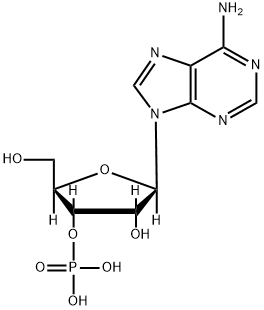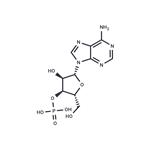Uses
Adenosine 3′-monophosphate (3′-AMP) is a metabolite produced from hydrolysis of 2′,3′-cAMP by a family of metal-dependent phosphodiesterases. 3′-AMP inhibits proliferation of preglomerular vascular smooth muscle cells and glomerular mesangial cells via A2B receptors. 2′,3′-cAMP and 3′-AMP represent a new unexplored pathway for adenosine-based cell regulation.
Definition
ChEBI: 3'-AMP is an adenosine 3'-phosphate with a monophosphate group at the 3'-position. It has a role as a mouse metabolite, a human metabolite and an Escherichia coli metabolite. It is an adenosine 3'-phosphate and a purine ribonucleoside 3'-monophosphate. It is a conjugate acid of a 3'-AMP(2-).
Purification Methods
It crystallises from large volumes of H2O in needles as the monohydrate, but is not very soluble in boiling H2O. Under acidic conditions it forms an equilibrium mixture of 2' and 3' adenylic acids via the 2',3'-cyclic phosphate. When heated with 20% HCl, it gives a quantitative yield of furfural after 3hours, unlike 5'-adenylic acid which only gives traces of furfural. The yellow monoacridine salt has m 175o(dec), and the diacridine salt has m 177o (225o)(dec). [Brown & Todd J Chem Soc 44 1952, Takaku et al. Chem Pharm Bull Jpn 21 1844 1973, NMR: Ts'O et al. Biochemistry 8 997 1969, Beilstein 26 III/IV 3607.]

